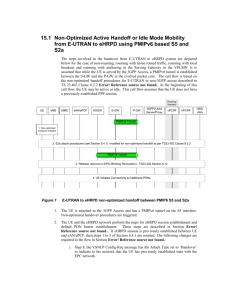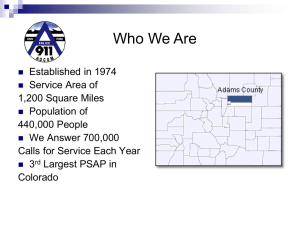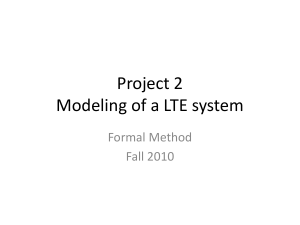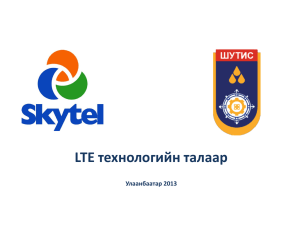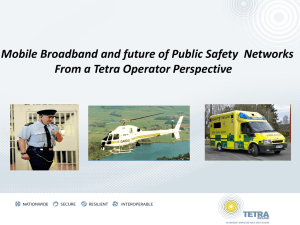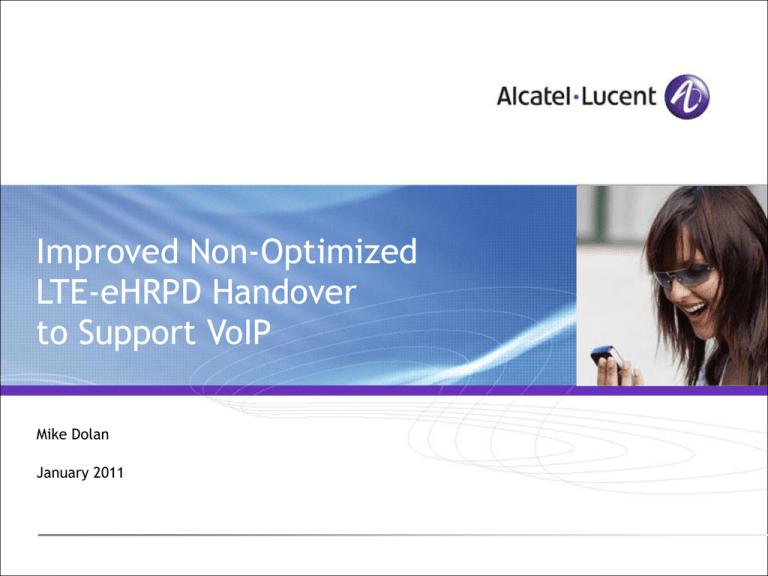
Improved Non-Optimized
LTE-eHRPD Handover
to Support VoIP
Mike Dolan
January 2011
Outline
GOAL: Improve non-optimized handover from LTE to eHRPD to support VoIP
handover in 500 ms or less.
Classify Handovers
Discuss Pre-registration
Explain “Lock PDN Connection” concept
Important air interface components of non-optimized handover
Timings:
Regular NOHO
Locked PDN NOHO
Locked PDN + No-Hash + CDMA System Time
Some Impacts to UEs and HSGWs
Summary
2 | Improved NOHO | January 2011
All Rights Reserved © Alcatel-Lucent 2011
Classifying LTE to eHRPD Handovers
Non-Optimized handover: Single Transmitter Devices
The topic of this discussion.
Non-Optimized handover: Dual Transmitter Devices
Not being discussed here.
Will require a separate, compatible approach using a new attach type.
Optimized handover: Involves the use of S101 to tunnel signaling.
Not being discussed here.
3 | Improved NOHO | January 2011
All Rights Reserved © Alcatel-Lucent 2011
Pre-Registration
To meet VoIP handover timing, it is necessary that the UE has previously
registered in eHRPD. For optimized handover, this would be done over S101.
For non-optimized handover today, this would only occur occasionally and is
not guaranteed.
A new method to guarantee pre-registration for VoIP capable devices is
necessary. The details will vary for a single transceiver vs. dual transceiver
device.
Several proposals have already been made in this area. This presentation
does not focus on the details of the pre-registration options that might be
standardized, only points out that it is necessary to add this technique.
In addition, under current NOHO the pre-registration (partial) context is
only held for a relatively short time. It is recognized that the time that the
pre-registered context is kept in the HSGW while the UE is attached on LTE
will need to be increased.
4 | Improved NOHO | January 2011
All Rights Reserved © Alcatel-Lucent 2011
Lock PDN Connection - Background
When designing handover from eHRPD to LTE, it was decided for simplicity
to delete all PDN connection context from the HSGW and keep only “partial
context” involving registration, authentication, and A10 connections.
When the UE returns to eHRPD from LTE, all PDN connections and
bearers need to be re-established using VSNCP and VSNP signaling.
This VSNCP and VSNP signaling requires approximately 500 ms. Of this,
300 ms is VSNP (RSVP) signaling.
NOTE: It may be possible to allow packets, e.g., VoIP packets, to run
over the main eHRPD service connection as best effort packets while the
VSNP signaling takes place to establish the QoS VoIP bearer.
The HSGW keeps “partial context” until a Context Maintenance timer
expires, or until the UE returns to the eHRPD radio.
THE PROBLEM The current design forces this extra 500 ms. into the voice
gap for VoIP services.
5 | Improved NOHO | January 2011
All Rights Reserved © Alcatel-Lucent 2011
Lock PDN Connection - Concept
The “Lock PDN Connection” concept is simple:
Create a PDN connection on eHRPD and “lock” it as a part of partial
context.
The HSGW will keep the locked PDN connection context, even when the
UE goes to LTE, in addition to the registration, authentication, and A10
connections it already keeps in partial context.
The UE guarantees the HSGW that it will make no changes to the PDN
connection configuration and bearers while on LTE.
When the UE returns to eHRPD from LTE, the VSNCP and VSNP signaling
are avoided, and the HSGW simply binds the PMIP tunnel with the P-GW
so that packets can begin flowing (approximately 25 ms).
NOTE: VSNP signaling may run in parallel to establish the VoIP QoS
bearer, if VoIP packets are initially sent over the main service conn.
Targeted specifically at handovers of VoIP calls from LTE to eHRPD.
6 | Improved NOHO | January 2011
All Rights Reserved © Alcatel-Lucent 2011
Lock PDN Connection – Procedure (part 1)
UE
eAN/ePCF
HSGW
LTE
P-GW
UE wakes up/
comes out of
radio blackout
and finds
eHRPD.
UE and eAN/ePCF establish eHRPD
radio context
UE and HSGW create a PPP session and authenticate
(interactions with HSS/AAA not shown)
UE creates (at least) the locked PDN connection for VoIP bearer and VoiP Bearer
UE goes idle on
eHRPD and
reselects to LTE
UE does a “handoff attach” on LTE for the existing PDN connection(s), and also creates other PDN
connections as needed. UE operates on LTE until HO.
P-GW tears down PMIP binding with the HSGW. The
HSGW keeps the locked PDN connection context.
7 | Improved NOHO | January 2011
All Rights Reserved © Alcatel-Lucent 2011
Lock PDN Connection – Procedure (part 2)
UE
eAN/ePCF
HSGW
LTE
P-GW
UE is operating on LTE.
upon LTE
measurement report at
edge of coverage, UE
is redirected to eHRPD
UE re-establishes eHRPD radio
connection. VoIP bearer
Reservation is set to the ON state.
eAN/ePCF notifies the HSGW that the
UE is operating on the eHRPD radio.
HSGW creates PMIP bindings for all
locked PDN connections.
VoIP packets can begin to flow on the main service connection as best effort.
VSNP signaling to establish the needed bearers.
VoIP packets can begin to flow on the new QoS bearer.
UE establishes other needed PDN connections and bearers using VSNCP and VSNP signaling with
the HSGW, and using eHRPD radio signaling with the eAN/ePCF as needed.
8 | Improved NOHO | January 2011
All Rights Reserved © Alcatel-Lucent 2011
No-Hash, CDMA System Time
Two important air interface components of improved non-optimized Handoff:
No-HASH:
When a UE finds multiple eHRPD channels in the information it receives
from the eNodeB, it chooses one and moves to it. eHRPD requires
receiving the channel configuration and then hashing to a specific
channel for load distribution. Hashing can use a significant amount of
time.
NOTE: The UE may obtain the eHRPD channel configuration and pre-hash
before leaving LTE, as a possible solution.
Avoiding this hashing in HO from LTE saves about 700 ms.
See the backup slides for more information on No-Hash.
CDMA System Time from LTE:
Provisions are made in E-UTRAN to provide the CDMA system time to the
UE, thus avoiding the time needed to acquire sync on the eHRPD radio.
Use of this facility in E-UTRAN saves about 200 ms.
9 | Improved NOHO | January 2011
All Rights Reserved © Alcatel-Lucent 2011
Timings
Assumptions: UE has a dual receiver. - The SIB8 contains information to help the UE find eHRPD. - UE has previously been
on eHRPD, so an eHRPD radio session exists.
FUNCTION
Determine to go to eHRPD.
Typical* Time
to Occur
No voice gap
contribution.
No voice gap
contribution.
Use SIB8 information (and extra
receiver) to find and acquire
eHRPD timing and overhead
signaling.
LTE Signaling to suspend traffic on No voice gap
LTE and begin move to eHRPD
contribution.
UE goes idle on LTE and
~700 ms.
reacquires eHRPD.
UE sets up eHRPD radio
~400 ms.
connection.
~4 sec
Establish PPP, Authentication
UE does VSNCP signaling to set up
the PDN connection for voice.
~200 ms.
~25 ms.
HSGW does PMIP bindings
UE does VSNP signaling to set up
eHRPD radio bearers
TOTAL Voice Gap (seconds)
~300 ms.
NOHO
No Context
NOHO
Partial Context,
No PDN
connections
Improved
NOHO
Locked PDN
connections
Improved
NOHO
Locked PDN +
No Hash
-
-
-
-
-
-
-
-
-
-
-
-
Applicable
Applicable
Applicable
Not Applicable
Applicable
Applicable
Applicable
Applicable
Applicable
Not Applicable
Not Applicable Not Applicable
Applicable
Applicable
Not applicable Not Applicable
No voice gap
No voice gap
contribution. In
contribution. In
parallel with VSNCP parallel with
signaling
VSNCP signaling
Applicable
Not Applicable
5.6
Applicable
Not applicable Not Applicable
1.3
1.13
* Typical Times: Values represent median sunny day scenarios from lab traces with early devices.
10 | Improved NOHO | January 2011
Applicable
All Rights Reserved © Alcatel-Lucent 2011
.43
Some Impacts to UEs
Impacts to System Selection
UE needs to go to eHRPD first (if available) and set up (at least) the
locked PDN connections, then go idle on eHRPD and reselect to LTE.
If UE loses radio contact longer than the Context Maintenance timer on
the HSGW allows, it must go to eHRPD upon return to coverage to reestablish locked PDN connections context. Then it will go to eHRPD idle
and reselect to LTE.
Context saving
UE must save locked PDN connection while on LTE.
LTE attach
UE must do “handoff attach” for established PDN connections when
attaching to LTE, instead of “initial attach”.
Radio
Add the No-Hashing capability for HO from LTE to eHRPD.
Note: This might be accomplished by having the UE read the eHRPD
channel configuration using a second receiver prior to leaving LTE and
performing the channel hash operation.
Use the LTE-provided CDMA System Time.
11 | Improved NOHO | January 2011
All Rights Reserved © Alcatel-Lucent 2011
Some Impacts to HSGWs
Implement PDN connection locking:
Accept and respond to a PDN connection locking request.
Add locked PDN connections to HSGW partial context procedures. This will have
implications on how much storage is needed per UE, and consequently on the
HSGW if many/most devices use locked PDN connections.
If H1 is implemented, add locked PDN connections to the context sent to the
target HSGW.
Create PMIP bindings for locked PDN connections immediately when the UE
returns from LTE.
12 | Improved NOHO | January 2011
All Rights Reserved © Alcatel-Lucent 2011
Summary
Locked PDN connections, in conjunction with the “no-hash” and CDMA
system time capabilities from LTE, can provide a NOHO voice gap time in
the range of 430 ms.
There will be impacts on the UE and HSGW, including system selection.
The locked PDN connection concept can also assist dual transmitter devices,
to solve the problem of recreating PDN connections upon temporary loss of
eHRPD radio coverage.
13 | Improved NOHO | January 2011
All Rights Reserved © Alcatel-Lucent 2011
BACKUP SLIDES
14 | Improved NOHO | January 2011
All Rights Reserved © Alcatel-Lucent 2011
Latency Reduction for LTE->eHRPD
Redirection
Dave Rossetti
Background
China Telecom submitted a contribution to 3GPP2 TSG-S wrt 1x CSFB call
setup optimizations.
S00-20090511-038r2
After ongoing discussions in CCSA, ALU submitted a 3GPP2 TSG-C contribution
for reducing latency due to hashing behavior during 1x Circuit Switch
Fallback.
ALU C20-20090615-019
The ALU technique has been summarized as a “No Hash” technique. An
alternative technique has also been discussed which is summarized as “prehash” although there has been no such contribution to 3GPP2.
A similar issue exists for LTE ->eHRPD redirection, albeit to a lesser extent.
If a UE is redirected to a multi-carrier eHRPD system, it may suffer hashing
related latency impacts on the order of .5 to 1 second prior to attaching
through eHRPD.
16 | Improved NOHO | January 2011
All Rights Reserved © Alcatel-Lucent 2011
Redirection Scenario showing area of impact
UE
eNB
MME
UE is in RRC_CONNECTED
2. RRC connection reconfiguration
(meas config, reporting
configuration, measurement gaps)
3. Measurement report (event B2)
4. RRC Connection Release with Redirection
info (CDMA Carrier)
S1 UE Context Release Procedure
1xEV-DO session establishment/re-establishment
Hashing
Delay
17 | Improved NOHO | January 2011
All Rights Reserved © Alcatel-Lucent 2011
1xEVDO
Performance Impact for Multi-carrier redirection
After the UE receives the RRC Redirection to eHRPD, it will attempt to
acquire the specified eHRPD carrier.
Once on eHRPD it will attempt to access the AN (to transmit UATIRequest or
ConnectionRequest etc based on eHRPD session state).
In order to access the eHRPD AN, it needs to acquire CDMA system time and
HRPD overhead information.
Assume CDMA system time is available from LTE SIB8.
HRPD overhead includes SystemParameters, QuickConfig, and
AccessParameters messages.
However, in a multicarrier eHRPD network, the SystemParameters message
(SPM) will contain multiple Channels/ExtendedChannels.
If a BTS is transmitting a N-channel SPM, then (N-1)/N of the ATs will end up
hashing upon acquiring that sector.
18 | Improved NOHO | January 2011
All Rights Reserved © Alcatel-Lucent 2011
Latency Impact
Per C.S0024-A, the recommended maximum number of control channel cycles
between 2 consecutive SectorParameter transmissions is 4 (NOMPSectorParameters)
Each control channel cycle is 256 slots, or 426.7ms. So this means that the
UE could wait up to 1.7 seconds to get the SectorParameters, only to be
told it needs to hash to another carrier.
Average delay would be ½ of this, 853ms.
In deployments, the SectorParameters is generally repeated every other cycle, so
the delay would only be up to 853ms.
– The SectorParameters can be a large message, so repeating it faster is
impractical.
Each HRPD sector is an independent AN*, so after hashing to the new channel,
the UE still needs to re-receive the overhead messages on the new sector.
However, if the UE has previously monitored this sector, and the signature
has not changed, it could restore previously received configuration without
further delay.
*A “sector” as specified in C.S0024-A is identified by (SectorID, CDMA Channel); perhaps more conventionally called a sector-carrier.
19 | Improved NOHO | January 2011
All Rights Reserved © Alcatel-Lucent 2011
Potential Solutions
So we have shown that in a N-carrier eHRPD system, some ATs may suffer up
to 1.7second latency due to hashing. Assuming an every-other-cycle repeat,
then the average latency is (N-1)/N * 853ms. So in a 2 carrier BTS the average
hashing latency is 427ms.
Two basic solutions can be considered to eliminate the hashing latency
without otherwise changing the callflow:
1) No Hash – UEs in this state do not hash from their assigned carrier.
2) Pre-Hash – During the redirection, the UE is given sufficient information
so it can select the correctly hashed eHRPD carrier initially.
20 | Improved NOHO | January 2011
All Rights Reserved © Alcatel-Lucent 2011
No Hash Solution
With the No Hash solution, the UE performs overhead acquisition normally,
but does not actually hash to a different carrier in the normal sunny day case.
The UE simply acquires overhead on the target carrier and accesses the target
carrier.
To avoid becoming lost, the UE only remains in this special no hash state for
a long enough time to setup a connection after the redirection. Otherwise
it reverts to normal behavior.
This type of behavior already exists in eHRPD—when the UE is listening to a
BCMCS flow, it may suspend hashing and remain indefinitely on a nonhashed BCMCS carrier.
Critical issue to be addressed is load balancing.
21 | Improved NOHO | January 2011
All Rights Reserved © Alcatel-Lucent 2011
Load Balancing
The main reason for hashing is to balance RAN access & control channel
loading across all the serving carriers.
Note that regardless of which carrier the UE uses to access the network,
the AN can always assign a different carrier for a traffic connection.
Hashing balances the load in aggregate, but is often ineffective at
balancing the instantaneous load.
If 2 UEs are simultaneously redirected to a 2 carrier eHRPD system with hashing,
then there is a 50% chance that they would both hash to the same carrier. i.e. the
load was not balanced.
Access/Control channel load balancing may not truly be necessary if
sufficient access/control channel resources are equipped.
With the No Hash option, if load balancing is desired it can be accomplished
by simple round-robin redirection from the eNB.
22 | Improved NOHO | January 2011
All Rights Reserved © Alcatel-Lucent 2011
Pre-Hash
The pre-hash solution would require tight coupling between the EUTRAN and
the underlying eHRPD network.
eNB would need to know detailed information about the underlying eHRPD
network, and this information would need to be changed in real time if the
underlying eHRPD network changed.
It also would require 3GPP and 3GPP2 standards changes, which would
delay availability.
While the pre-hash solution is adequate, Alcatel-Lucent believes the “No
Hash” Solution to be superior.
23 | Improved NOHO | January 2011
All Rights Reserved © Alcatel-Lucent 2011
Next Steps
Alcatel-Lucent will bring a contribution to 3GPP2 TSG-C proposing to add text
to C.S0087 stating that the UE will temporarily skip the performance of
channel hashing after redirection from LTE.
Changes to UE are required.
No changes to eHRPD RAN or LTE EUTRAN are required, although
implementation of the round robin assignment in the eNB would be
optional.
24 | Improved NOHO | January 2011
All Rights Reserved © Alcatel-Lucent 2011


